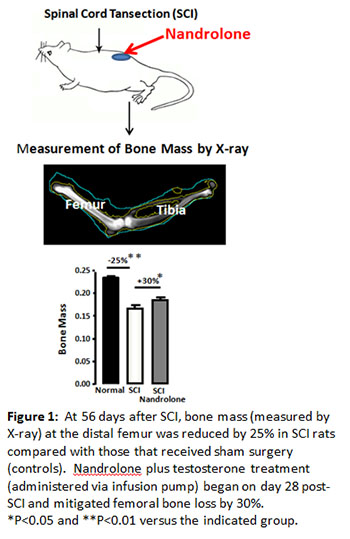


Posted August 14, 2014
Weiping Qin, M.D., Ph.D., Mount Sinai School of Medicine and James J. Peters Veterans Affairs Medical Center
 Spinal cord injury (SCI) leads to rapid and extensive bone loss, which is associated with an elevated risk of pathologic fractures and morbidity, and an increased financial burden. The lifetime prevalence of fractures is reported to be 25% to 46% in persons with SCI. There is currently no practical treatment to prevent bone loss or promote rebuilding of bone in individuals with SCI. Dr. Qin received a FY09 Exploration - Hypothesis Development Award to explore this treatment gap and, together with collaborators at the USDA Agriculture Research Service's Human Nutrition Research Center, Indiana University-Purdue University, and Amgen, Inc., he investigated the potential of nandrolone, a synthetic androgen and anabolic steroid, to reduce bone loss after SCI.
Spinal cord injury (SCI) leads to rapid and extensive bone loss, which is associated with an elevated risk of pathologic fractures and morbidity, and an increased financial burden. The lifetime prevalence of fractures is reported to be 25% to 46% in persons with SCI. There is currently no practical treatment to prevent bone loss or promote rebuilding of bone in individuals with SCI. Dr. Qin received a FY09 Exploration - Hypothesis Development Award to explore this treatment gap and, together with collaborators at the USDA Agriculture Research Service's Human Nutrition Research Center, Indiana University-Purdue University, and Amgen, Inc., he investigated the potential of nandrolone, a synthetic androgen and anabolic steroid, to reduce bone loss after SCI.
Dr. Qin and colleagues demonstrated in a rat model of spinal cord transection (T9-T10) that animals receiving a SCI experienced a 25% reduction in femoral bone mass after 56 days compared to those receiving sham surgery (controls). In the treatment group, nandrolone (0.75 mg/kg/week) plus testosterone (2.8 mg/kg/day to control for effects of nandrolone on circulating testosterone levels) began on day 28 post-SCI and resulted in mitigation of SCI-induced bone loss by 30% (Figure 1).
The researchers also investigated the mechanism through which nandrolone exerts this protective effect. They determined that nandrolone may act through the activation of an important molecular signaling pathway related to bone biology, the Wnt signaling pathway. To test a known activator of Wnt signaling for its effect on SCI-induced bone loss, SCI rats were treated with anti-sclerostin antibodies (i.p. 25 mg/kg/week) beginning 7 days post-injury. Preliminary data demonstrated that anti-sclerostin antibodies almost completely blocked bone loss in the femur, tibia, and lumbar spine. This exciting finding marks the first evidence that SCI-induced bone loss can be completely blocked.
Dr. Qin continues to pursue nandrolone and anti-sclerostin antibodies as therapeutic approaches for mitigating SCI-induced bone loss and plans to investigate whether the two drugs might act synergistically as an effective combination therapy for acute and/or chronic SCI.

Related Publication:
Sun L, Pan J, Peng Y, Wu Y, Li J, Liu X, Qin Y, Bauman WA, Cardozo C, Zaidi M, Qin W. 2013. Anabolic steroids reduce spinal cord injury-related bone loss in rats associated with increased Wnt signaling. The Journal of Spinal Cord Medicine 36(6):616-622.
Links:














